| Article ID | Journal | Published Year | Pages | File Type |
|---|---|---|---|---|
| 4558017 | Journal of Invertebrate Pathology | 2009 | 6 Pages |
The interactions that occur between the entomopathogenic fungus Pandora neoaphidis and a predator (Coccinella septempunctata) and a parasitoid (Aphidius ervi) were assessed in microcosm and polytunnel experiments. Transmission of P. neoaphidis to the pea aphid, Acyrthosiphon pisum, was enhanced in the presence of both C. septempunctata and A. ervi in microcosm experiments done under fixed abiotic conditions. In contrast, the reproductive success of A. ervi was reduced in the presence of P. neoaphidis. Despite the increased fungal transmission in the presence of C. septempunctata, there was no additional decrease in the aphid population indicating that P. neoaphidis is functionally redundant in the presence of the coccinellid. In polytunnel experiments the reproductive success of A. ervi was not affected by P. neoaphidis. These results do not support those of the microcosm and may be due to the more natural abiotic conditions in the polytunnel reducing the competitive advantage of the fungus. Microcosms therefore provide an arena in which the interactions between fungal pathogens and other aphid-natural enemies can be assessed however, further assessments at increased spatial scales under more natural abiotic conditions are also required to accurately determine the outcome of these interactions.
